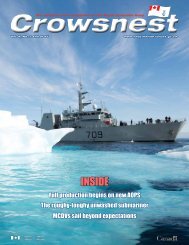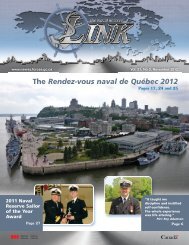You also want an ePaper? Increase the reach of your titles
YUMPU automatically turns print PDFs into web optimized ePapers that Google loves.
3.2 Submarine Cables<br />
Given <strong>the</strong>ir significance to global communications <strong>and</strong> commerce (as discussed earlier), experts<br />
frequently draw attention to <strong>the</strong> vulnerability <strong>of</strong> undersea cables to damage. Regardless <strong>of</strong><br />
whe<strong>the</strong>r <strong>the</strong> damage is intentional or <strong>the</strong> consequence <strong>of</strong> accident or natural disaster, <strong>the</strong> impact<br />
when such damage has occurred has been considerable. Natural phenomena account for about<br />
10 percent <strong>of</strong> <strong>the</strong> damage to submarine cables. Underwater currents (“turbidity currents”) created<br />
by undersea earthquakes can flow for hundreds <strong>of</strong> kilometres with sufficient power to snap<br />
cables. One such incident followed <strong>the</strong> Hengchun earthquake near Taiwan in December 2006 <strong>and</strong><br />
affected undersea cable connections to China, Japan, <strong>the</strong> Philippines, Singapore, Taiwan <strong>and</strong><br />
Vietnam, with <strong>the</strong> result that it took 11 ships <strong>and</strong> 49 days to repair. 88 In o<strong>the</strong>r cases,<br />
storm-induced wave action, as happened with Hurricane Iwa (1982) near Hawaii <strong>and</strong> Hurricane<br />
S<strong>and</strong>y (2012) <strong>of</strong>f New Engl<strong>and</strong>, each broke a number <strong>of</strong> submarine cables. Violent storms have<br />
also severely damaged shore-based cable stations. Looking to <strong>the</strong> future, submarine cable<br />
networks will not be immune from <strong>the</strong> effects <strong>of</strong> climate change, with a projected increase in<br />
number <strong>and</strong> intensity <strong>of</strong> major storms. 89<br />
Never<strong>the</strong>less, a 2007 study concluded that more than three-quarters <strong>of</strong> all cable faults are caused<br />
by human activity. 90 Most <strong>of</strong> this occurs on <strong>the</strong> continental shelf in waters less than 200 metres<br />
deep <strong>and</strong> is <strong>the</strong> result <strong>of</strong> ships’ anchors, fishing behaviour <strong>and</strong> dredging activities. In one case, in<br />
1986 a Chilean container ship accidentally broke three <strong>of</strong> four trans-Atlantic cables by mistakenly<br />
dragging its anchor chain for several kilometres <strong>of</strong>f <strong>the</strong> coast <strong>of</strong> New Jersey. 91 That an estimated<br />
65 percent <strong>of</strong> unintentional damage to submarine cables is occurring in coastal waters is not<br />
surprising given <strong>the</strong> intensification <strong>of</strong> human activity <strong>the</strong>re in recent decades. 92<br />
Intentional damage to submarine cables, a new <strong>and</strong> at present a relatively rare occurrence, has<br />
become a concern for those looking at critical infrastructure protection. In both world wars,<br />
cutting undersea cables was a highly effective means <strong>of</strong> disrupting enemy communications. 93<br />
Cables were also a target <strong>of</strong> espionage in <strong>the</strong> Cold War with <strong>the</strong> US tapping Soviet undersea<br />
cables, <strong>and</strong> more recent revelations indicate that cables continue to be viewed as an important<br />
88 Chih-Chieh Su, Jing Ye-Tseng, Ho Han-Hsu, Cheng Shing-Chiang, Ho-Shing Yu, Saulwood Lin, <strong>and</strong><br />
James T. Liu, “Records <strong>of</strong> Submarine Hazards <strong>of</strong>f SW Taiwan” J. P. Terry <strong>and</strong> J. G<strong>of</strong>f (eds.), Natural<br />
Hazards in <strong>the</strong> Asia-Pacific Region: Recent Advances <strong>and</strong> Emerging Concepts (Geological Society:<br />
London, 2012), p. 45. For <strong>the</strong> impact on Taiwan, see Jon Herskovitz <strong>and</strong> Rhee So-eui, “Taiwan quake<br />
shakes confidence in undersea links”, <strong>The</strong> Washington Post, 28 December 2006.<br />
89 Carter, “Submarine Cables <strong>and</strong> Natural Hazards”, in Burnett et al., Submarine Cables: <strong>The</strong> H<strong>and</strong>book <strong>of</strong><br />
Law <strong>and</strong> Policy, pp. 241–252.<br />
90 Robert Wargo <strong>and</strong> Tara M. Davenport, “Protecting Submarine cables from Competing Uses”, in Burnett<br />
et al., Submarine Cables: <strong>The</strong> H<strong>and</strong>book <strong>of</strong> Law <strong>and</strong> Policy, p. 256.<br />
91 <strong>The</strong> incident is described in Mick Green <strong>and</strong> Keith Brooks, “<strong>The</strong> Threat <strong>of</strong> Damage to Submarine Cables<br />
by <strong>the</strong> Anchors <strong>of</strong> Ships Underway”, CIL-ICPC Workshop on <strong>the</strong> Protection <strong>of</strong> Submarine Cables<br />
(National University <strong>of</strong> Singapore: 2011) [accessed on 20 February 2015 at<br />
http://cil.nus.edu.sg/programmes-<strong>and</strong>-activities/past-events/international-workshop-cil-icpc-workshop-on-<br />
<strong>the</strong>-protection-<strong>of</strong>-submarine-cables/powerpoint-presentations-<strong>and</strong>-papers-presented-at-<strong>the</strong>-2011-<br />
workshop/], p. 3, fn. 4.<br />
92 Lionel Carter, “Submarine Cables <strong>and</strong> Natural Hazards”, in Burnett et al., Submarine Cables: <strong>The</strong><br />
H<strong>and</strong>book <strong>of</strong> Law <strong>and</strong> Policy, p. 238.<br />
93 Jessica Woodall, “Australia’s vulnerable submarine cables”, <strong>The</strong> Strategist (online), 31 May 2013.<br />
DRDC-RDDC-2016-R085 21




